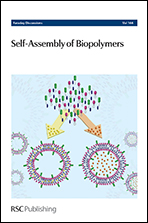Self-assembly of natural and synthetic drug amphiphiles into discrete supramolecular nanostructures
Abstract
Molecular assembly provides an effective approach to construct discrete supramolecular nanostructures of various sizes and shapes in a simple manner. One important technological application of the resulting nanostructures is their potential use as anticancer drug carriers to facilitate targeted delivery to tumour sites and consequently to improve clinical outcomes. In this carrier-assisted delivery strategy, anticancer drugs have been almost exclusively considered as the cargo to be carried and delivered, and their potential as molecular building blocks has been largely ignored. In this discussion, we report the use of anticancer drugs as molecular building units to create discrete supramolecular nanostructures that contain a high and quantitative drug loading and also have the potential for self-delivery. We first show the direct assembly of two amphiphilic drug molecules (methotrexate and folic acid) into discrete nanostructures. Our results reveal that folic acid exhibits rich self-assembly behaviour via Hoogsteen hydrogen bonding under various solvent conditions, whereas methotrexate is unable to assemble into any well-defined nanostructures under the same conditions, despite its similar chemical structure. Considering the low water solubility of most anticancer drugs, hydrophilic segments must be conjugated to the drug in order to bestow the necessary amphiphilicity. We have demonstrated this for camptothecin through the attachment of β-sheet-forming peptides with overall hydrophilicity. We found that the intermolecular interactions among camptothecin segments and those among β-sheet peptides act together to define the formation of stable one-dimensional nanostructures in dilute solutions, giving rise to nanotubes or nanofibers depending upon the processing conditions used. These results lead us to believe that self-assembly of drugs into discrete nanostructures not only offers an innovative way to craft self-delivering anticancer drugs, but also extends the paradigm of using molecular assembly as a toolbox to achieve functional nanostructures, to a new area which is specifically focused on the direct assembly of functional molecules (e.g. drugs, or imaging agents) into nanostructures of their own.
- This article is part of the themed collection: Self-Assembly of Biopolymers

 Please wait while we load your content...
Please wait while we load your content...